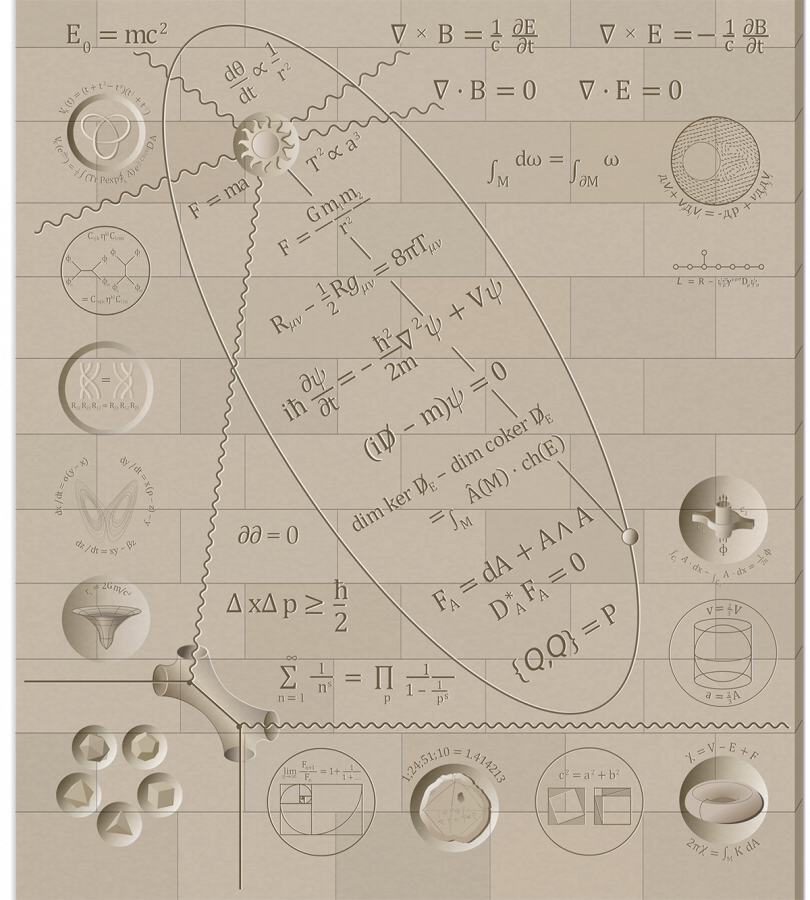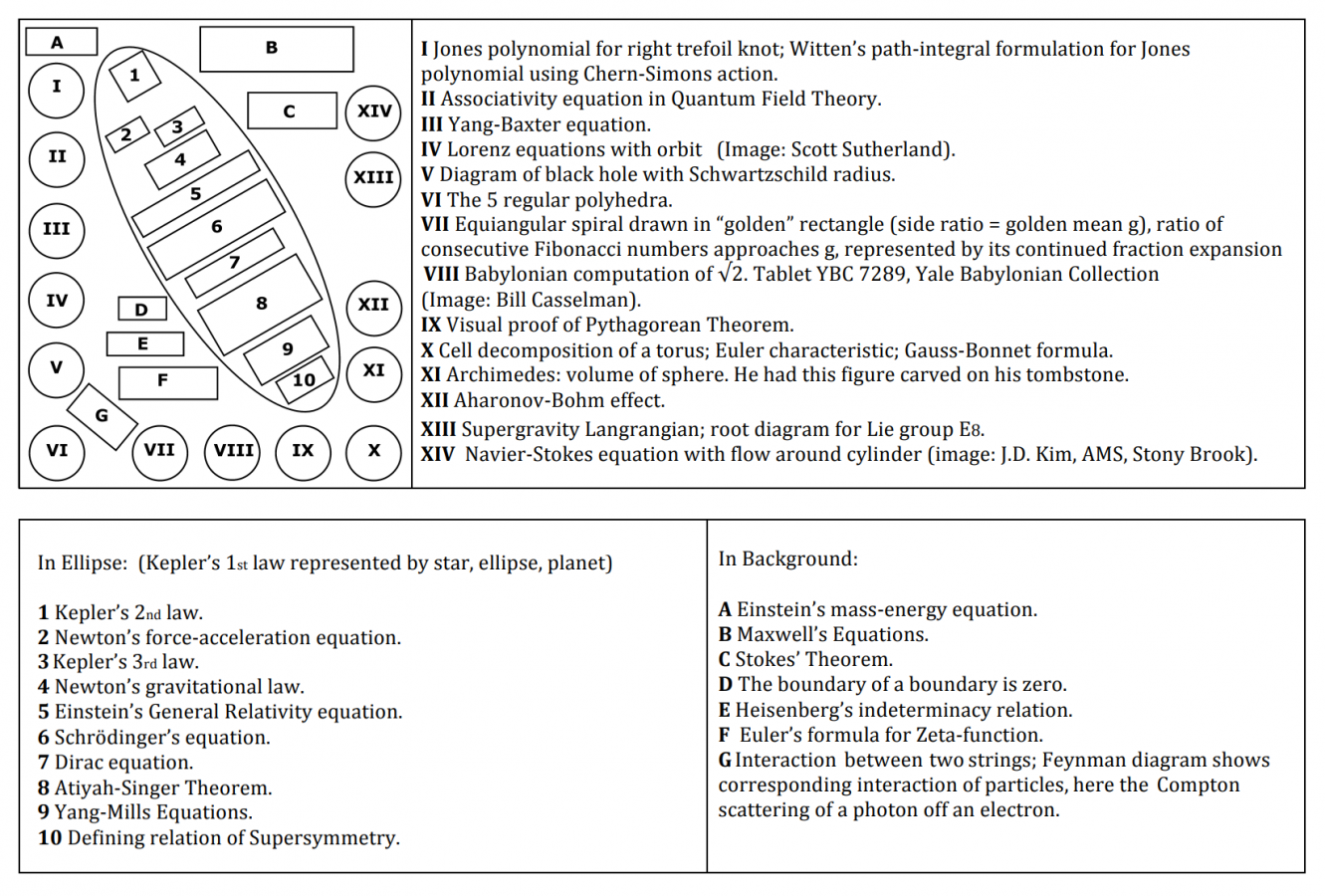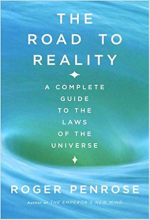Graph, Wall, Tome
Fundamental physics is an unknown world to most people. Equations, symbols, and incomprehensible terms abound, and unless you've studied post-grad mathematics and physics, this world is inaccessible to you. Although there are several great resources to map the way toward complete understanding. Most people will not undertake the journey to understand the source code to the world that we all inhabit.
The goal of the Graph, Wall, Tome project is to solve this problem by building a portal anyone can use to travel to the amazing world that we call fundamental physics.
The name of the project stems from the fact that there are three resources that themselves contain all that you need for an almost complete understanding of the world.
- The Graph - A paragraph written by Edward Witten
- The Wall - The iconic wall of Stony Brook University
- The Tome - The book 'The Road to Reality' by Roger Penrose
These resources are available to everyone, but will be sought by almost none. A goal of the Graph, Wall, Tome project is to convert these resources into a medium that can be widely disseminated, and which can not be ignored.
This project will require bi-directional information transfer, and the minds of people with many different aptitudes.
- We need mathematicians, topologists, geometers, and physicists to understand these resources, and all of their implications.
- We need explainers and educators, to convey this information to a wider audience, and
- We need artists, linguists, and programmers to create intuitive visualisations.
The Portal will create a community of people, working together to achieve these aims.
Success will generate yet further insights, opening up a more fundamental understanding of the nature of reality - for the individuals involved, and - for humanity as a whole.
Eric Weinstein's Prompt
A request: Try to draw the lines through the three. View it as a unified idea:
The paragraph gets edited.
The wall gets defaced and grafittied.
The Sacred Tome gets Re-Written
But follow the skeins through each.
The graph points to the wall.
And the wall to the Tome.
And the Tome leads to the Search.
The Graph, The Wall, The Tome
The Graph
The Graph is a paragraph from Edward Witten's paper Physics and Geometry:
If one wants to summarize our knowledge of physics in the briefest possible terms, there are three really fundamental observations: (i) Spacetime is a pseudo-Riemannian manifold $$M$$, endowed with a metric tensor and governed by geometrical laws. (ii) Over M is a vector bundle $$X$$ with a non-abelian gauge group $$G$$. (iii) Fermions are sections of $$(\hat{S}{+} \otimes V{R}) \oplus (\hat{S}_ \otimes V_{\bar{R}})$$. $$R$$ and $$\bar{R}$$ are not isomorphic; their failure to be isomorphic explains why the light fermions are light and presumably has its origins in representation difference $$\Delta$$ in some underlying theory. All of this must be supplemented with the understanding that the geometrical laws obeyed by the metric tensor, the gauge fields, and the fermions are to be interpreted in quantum mechanical terms.
The paragraph is found at the bottom of page 20.
The Wall
The following image is carved into a wall at Stony Brook University. It contains many of the most fundamental equations of physics, providing a formulaic representation of all reality.
The Tome
The Tome is the book Road to Reality by Roger Penrose which contains a comprehensive account of the physical universe. To gain an understanding and intuition for the information contained in 'The Graph', and 'The Wall', reading this book will provide a great head-start. With 34 chapters spread over 1000 pages, including diagrams, equations, and descriptions, there are multiple avenues for understanding all concepts.
- ISBN: 978-0679776314
- Road to Reality by Roger Penrose (2004)
- Purchase the book somehow, then get the PDF here
- There appears to be a Kindle Edition that isn't available in the US. If anyone in the community has a way to get a Kindle version of the book, please add it here.
Ongoing Sub-Projects
- Editing the Graph
- Annotating the Wall
- Animating the Wall
- Defacing the Wall
- Annotating the Tome
- Decoding the Graph-Wall-Tome Connection
Further Project Ideas
- Create/assemble resources that provide a geometric intuition for the equations and principles of fundamental physics - Geometric interpretations are most amenable to being visually represented. An example, is shown here.
- Create Accelerators: 2 minute guides to fundamental principles.
- Create/assemble resources that allow uninitiated to quickly and easily get up to speed with state of the project.
- Create/assemble resources that provide analogies for more complex principles - to demonstrate a key feature of the principle.
Resources & References
- Files related to the projected can be found in a Google Drive Folder.
- List of Tasks related to the Project (no longer up to date)
- Recording of original call w/ Eric
- Eric’s Most Important Set of Books
- The Physics Travel Guide (A didactic Wiki that explains concepts in three levels of difficulty.)
- Information about the GWT project were first collected in a Google Doc titled Graph, Wall, Tome - Problem Solving.
- Relevant conversations with Eric on The Portal Discord Server
- Misc recordings on The Portal Server for project and other notable conversations



